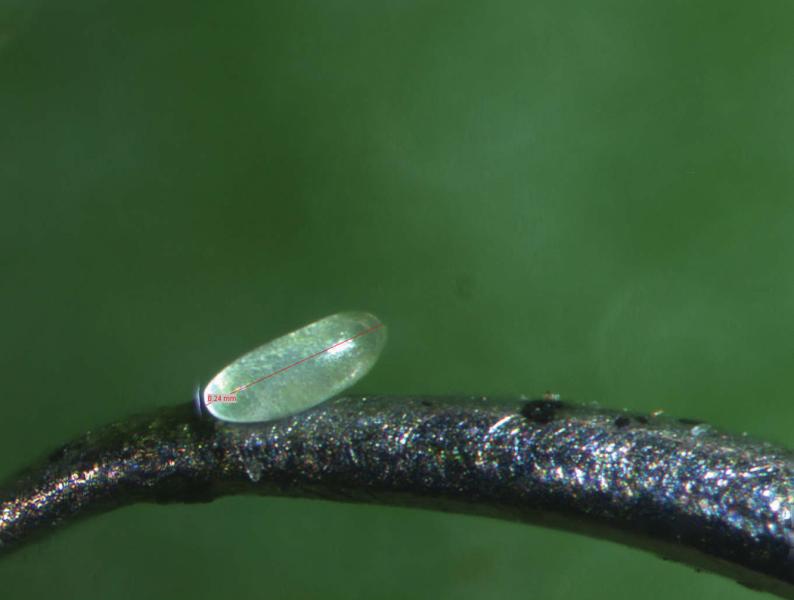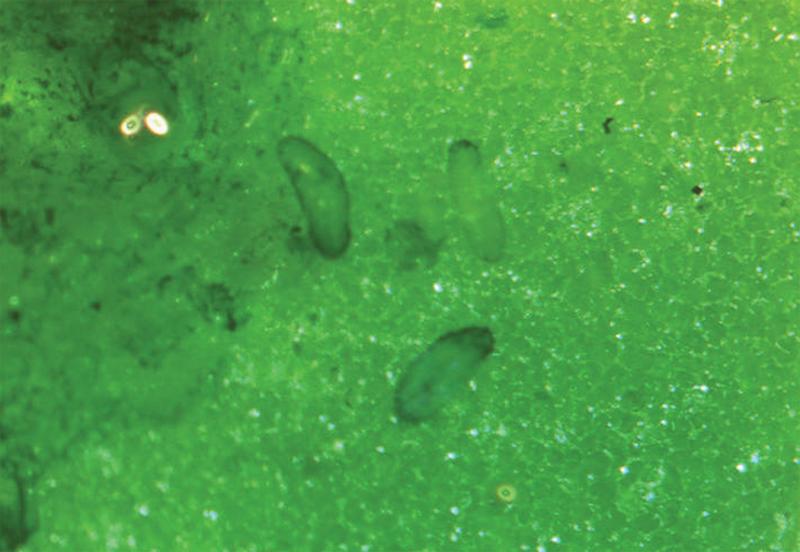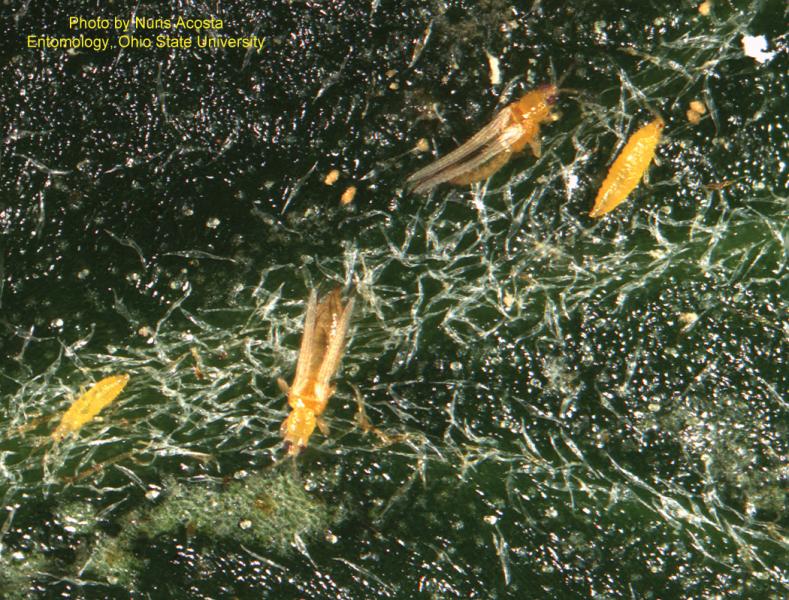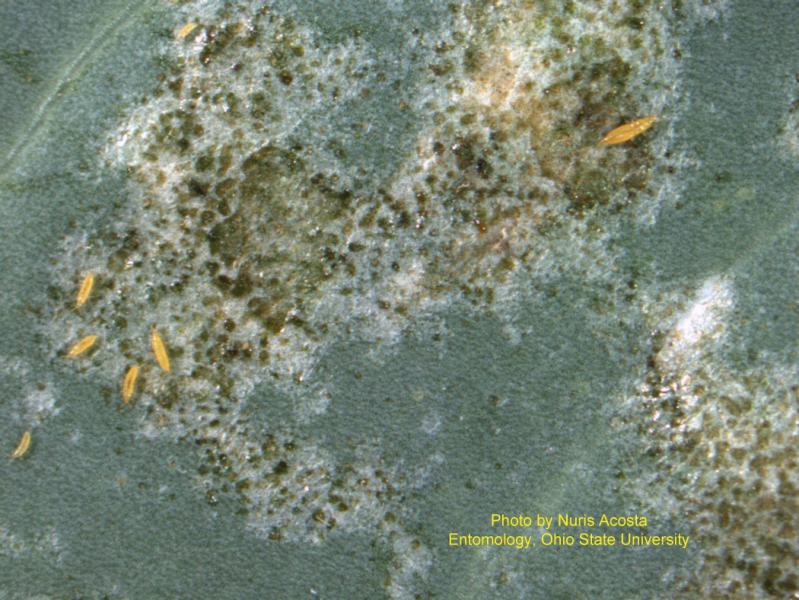Managing Thrips: Resistance to Insecticides
Western flower thrips are some of the most common and damaging insects found on plants grown in greenhouses. These insects have many characteristics that help them become pests; they have a short life cycle going from egg to adult in about two weeks, depending on temperature. They reproduce quickly and in high numbers. A single female thrips can produce up to 250 eggs, which are placed inside leaf tissue (Figure 1). In addition, Western flower thrips are really good at hiding due to their small size (Figure 2), develop resistance to insecticides rapidly and move well from one place to the next. Western flower thrips damage leaves by breaking the cells and then feeding from the cell contents, leaving a characteristic pattern of damage on the leaf tissue (Figure 3).
One of the most important tools to control insects on any integrated pest management (IPM) program is the use of insecticides. However, the overuse of insecticides invariably leads to the development of insect populations that are resistant to such insecticides. Therefore, it is important to prevent insecticide resistance with the use of insecticide resistance management (IRM) techniques.
In general terms, insecticide resistance occurs when insect populations are subjected to insecticide applications that kill the most susceptible individuals, leaving those that are less susceptible to reproduce and increase the population. How quickly insecticide resistance develops depends on many factors including the type of insecticide used, how often it is used and how capable the insect is in detoxifying the insecticide. In general terms, one of the goals of a good integrated pest management program should be to prevent the development of insecticide resistance on target insect populations.
Ways to Prevent Insecticide Resistance
There are different strategies that need to be considered when developing insecticide resistance management plans. These could be separated into two groups: a) insect outbreak prevention and b) insecticide management. Among insect outbreak prevention strategies we could list: identification and sampling, cultural control, biological control and personnel training. Among insect management strategies we could include : overall insecticide use on the production system, monitoring populations for changes in susceptibility to insecticides, establishing insecticide rotations employing products from a different mode of action groups, proper application timing and insecticide delivery. All of these elements will be discussed below.


Figure 1. Western flower thrips eggs are laid inside leaf tissue therefore are not exposed to insecticide applications. Western flower thrips eggs inside leaf tissue and stained using vinegar for observation (left), a single Western flower thrip egg removed from leaf tissue (right).
Identification and Sampling
Proper insect management requires the correct identification of the arthropod causing the problem. Improper identification can lead to inadequate insecticide selection to control insect outbreaks and could exacerbate resistance issues. If you cannot identify a particular insect problem, then you should send samples to pest diagnostic clinics. An example of such facility is The C. Wayne Ellett Plant and Pest Diagnostic Clinic at The Ohio State University (http://ppdc.osu.edu).
Please make sure you contact the facility beforehand so you follow all the recommendations for sample shipping. Another crucial element when dealing with an insect pest is being able to detect if the insect population is growing or not; therefore a successful sampling program is key. Thrips are usually best sampled with the use of yellow sticky traps. While other sticky card colors are useful (i.e. blue), yellow sticky cards allow for efficient capture of thrips and other insects including whiteflies and fungus gnats. When developing sampling procedures it is important to designate a specific person to manage sampling and reporting of insect infestations.


Figure 2. Western flower thrip adult showing its characteristic fringed wings (left), and adults and nymph far right (right). Pictures taken by Nuris Acosta, Entomology, Ohio State University.
Sanitation
Excellent sanitation practices go a long way in preventing insect outbreaks. Preventing thrips entrance through the use of screens, or by repairing any holes found on walls and entrances, should be considered especially in facilities producing high value plants that are susceptible to viruses transmitted by thrips. Grassy areas surrounding the greenhouse should be well maintained to prevent thrips from breeding outside the greenhouse.
Any weeds and algae growing below benches need to be removed and, if possible, bare soil areas should be covered using weed barriers or similar. Trash containers where plants are disposed need to be covered or the trash needs to be removed periodically so they do not become contamination areas. Incoming plant shipments need to be thoroughly inspected and treated if problems are found before these plants are moved into the facility. Properly cleaning and disinfecting an area where plants were finished is very important. If possible proper cleaning of an area should include a “free plant period” where the area is left free of plants. When this is not possible it’s important to disinfect the area thoroughly before a new set of plants is introduced.
Cultural Practices
Proper fertilization and irrigation programs are key, not only to grow healthy plants but also to reduce attack by insects. Overfertilized plants are often more attractive to insects because they produce more offspring when feeding on them. Often it is easier to keep plants well watered and fertilized when using an automated irrigation and fertilization system. When an automated irrigation system is not available it is critical to teach workers how to water and fertilize plants properly.
Biological Control
Over the past few years the use of biological control agents has increased. In Ohio, there are several facilities that rely primarily on biological control for their thrips management while others are using it in combination with other tactics including insecticides. Keep in mind that in my opinion biological control should be used as a prevention tactic in greenhouses. This means that biological control agents should be released even before thrips outbreak happen.
Biological control programs against thrips usually include multiple agents like the fungi Beauveria bassiana and the predatory mite Amblyseius swirskii. When using biological control agents it is very important to develop the program before the season starts and to establish a good partnership with the vendor of such agents. More information about
vendors of biological control agents can be found out at the Association of Natural Biocontrol Producers (http://www.anbp.org).
Overall Insecticide Use and Monitoring Susceptibility
When the decision is made that insecticides need to be used to reduce an outbreak it is important to put these in the context of insecticide use throughout the facility. And to select the best possible insecticide, beyond cost considerations and efficacy you will need both good insect sampling and insecticide application records. For example, if a product is very effective against two insect pests its use should be reduced against one of the pests where other alternatives are available.
Monitoring of insecticide susceptibility should be done by researchers, but if you suspect that a particular insect population in your facility might be resistant it might be a good idea to get in contact with your extension educator to ask questions about the evaluation of such populations. And if such evaluations are available you could obtain information about how resistant some of these populations are.


Figure 3. Western flower thrips adults and nymphs on leaf tissue (left), damage caused by thrips (right). Pictures taken by Nuris Acosta, Entomology, Ohio State University.
Rotations Employing Different Modes of Action
One of the most important techniques to prevent or to slow down insect resistance is to develop a good rotation program that employs the use of products from different mode of action groups. Simply, the mode of action of a product is how it affects the physiology of the insect. Therefore a proper rotation includes products from different mode of action groups that affects the physiology of the insect in very distinct ways. All the known mode of action groups and examples of active ingredients belonging to different mode of action groups can be found at the website of the Insecticide Resistance Action Committee (IRAC – www.irac-online.org).
One example of a rotation program includes (active ingredients are in parenthesis): Conserve (spinosad), Pylon (chlorfenapyr), Overture (pyridalyl), Hachi-Hachi (tolfenpyrad), Avid (abamectin), Pedestal (novaluron), BotaniGard (Beauveria bassiana). Since the previous example does not include all available insecticides capable of killing thrips, there are many other possible rotations that are not included here. Make sure that you consult with your local extension educator for the most up-to-date pesticide recommendations against thrips, and remember to always read the labels properly before any application.
Proper Application Timing and Insecticide Delivery
During the selection of a product rotation it is important to decide how often a product can be used before we switch to a different compound. The most common recommendation is to use the same product twice, if applications are done on a weekly schedule, before moving to a product from a different mode of action group. The idea is to expose one thrips generation to one compound before moving to the next one. Insecticides need to be used against the most vulnerable life stages of the thrips.
Keep in mind that it is critical to make sure the application equipment is working properly before attempting any insecticide application. Unfortunately, it is common to see applications failing because of improper equipment use. Important considerations are: water pH and alkalinity, water volume, nozzle type and pressure. Furthermore, the equipment needs to be tested and calibrated at least once before the start of a major season. Water sensitive paper can be used to measure deposition.


 Video Library
Video Library 




















